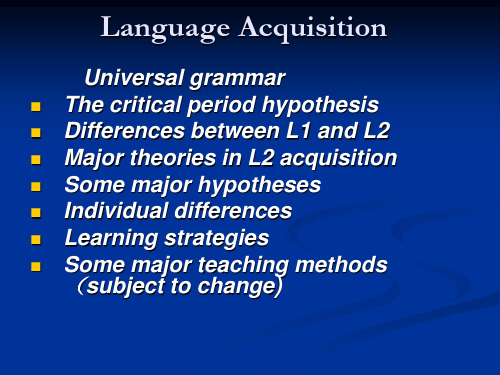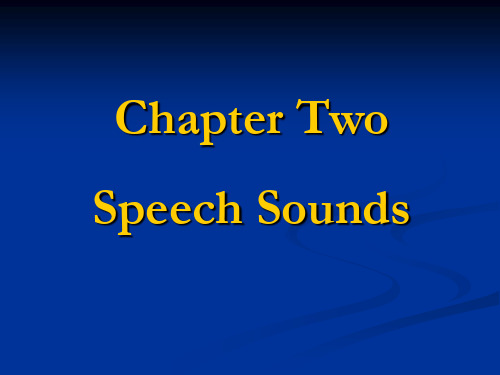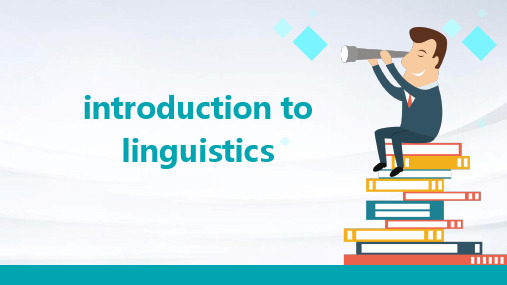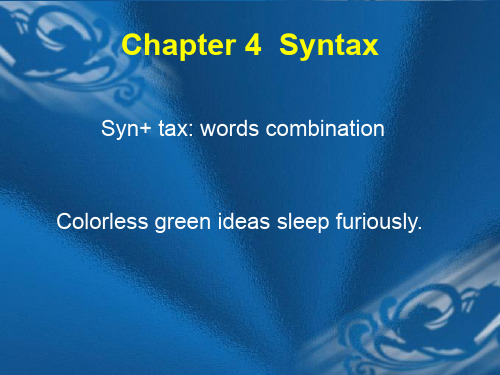英语专业语言学课件
语言学-第三章PPT课件

-
13
(2) In terms of meaning:
Grammatical/Function words (express grammatical meanings, linking): conjunctions, prepositions, articles, pronouns.
Lexical/Content words (having lexical meaning, refer to substance, action &quality): nouns, verbs, adjectives, adverbs.
relationship of “a kind of something”, eg scarecrow: not a kind of crow breakneck: not a kind of neck
-
26
Written forms of compounds
Solid: blackboard, teapot, bodyguard Hyphenated: wedding-ring, wave-length Open: coffee table, washing machine Free variation: businessman, business-man, business
language acquisition 英语专业语言学PPT

The Critical Period Hypothesis
The end of the critical period is the point at which the nature of language learning changes from being an automatically engaged process to one in which it becomes yet another cognitive activity, a modularity organized on the basis of information-processing stages: input, central processing, and output (Skehan 233, 283).
Differences between L1 Acquisition and L2 Learning
But L2 learning is different. The bulk of the evidence indeed comes from sentences the learner hears—positive evidence from linguistic input. But the L2 learners also has the L1 available to them. Negative evidence can be used to work out what does not occur in L2 but might be expected to occur if it were like L1.
Language Acquisition
Universal grammar The critical period hypothesis Differences between L1 and L2 Major theories in L2 acquisition Some major hypotheses Individual differences Learning strategies Some major teaching methods
精心整理全套英语专业语言学课程课件_期末考试必备语言学Chapter_2_sound(1)

Position of the vocal folds: voiceless
Position of the vocal folds: voicing (initial & the widest aparting)
Voiced Sounds
Voiceless Sounds
Position of the vocal folds: glottal stop
Its main principles of IPA:
there should be a separate letter for each distinctive sound, and that the same symbol should be used for that sound in any language in which it appears. The alphabet was to consist of as many Roman alphabet letters as possible, using new letters and diacritics only when absolutely necessary.
Chapter Two
Speech Sounds
Phonetics
Study of Speech Sound Phonology
Phonetics studies how speech sounds are produced, transmitted, and perceived.
Articulatory Phonetics is the study of the production of speech sounds. Acoustic Phonetics is the study of the physical properties of speech sounds. Perceptual or Auditory Phonetics is concerned with the perception of speech sounds.
英语专业语言学Psyling2011-1ppt课件

理语言学(computational psycholinguistics)
• 心理语言学研究对象: • 语言习得及语言使用的心理过程 • 理论语言学:研究语言结构 • 社会语言学: 研究语言功能 • 收音机(结构:原件、材料和线路图) • ---话语(语音、词汇和语法系统) • 功能:接收声波(长中段波)---表达、交
流思想(陈述、感情、疑问等)
心理学根源
• 1879, Wundt, Leipzig university, psycholab
• 认为:像感觉、情感、意象那样的心理现 象都可以用自然科学的研究方法进行观察 和研究。
• 心理学家可以像物理学家把复杂的化合物 分解为一样,研究经验的元素,把复杂的 感觉和感情分解为人类经验的“原子”。
• 相关性研究(correlational study) • 也是自然观察。 • 2个或多个属性的相互关系。 • 如抽烟与肺癌的关系。 • 1-2 实验方法 • 是有控制的观察。 • 任何一种行为都是多种因素起作用的结果。 • 控制其他因素,专门操纵某一因素,使它做系统
的改变,从而观察其作用。
• 如学习时间、方法、材料、年龄、老师等与英语 考试成绩的关系。
• A.人们是怎样理解和产生语言的---实验心理语 言学(experimental psycholinguistics)
• B.儿童是怎样习得母语的---发展心理学 (developmental psycholinguistics)
• C. 心理语言学的研究成果是怎样应用到其他领域 的---应用心理语言学
手段,主要研究个体心理差异。 • 主要内容:测量阈限和等价刺激等的心理物理法;感觉量
语言学概论ppt课件英文

Through language, children learn the values, norms, and beliefs of the culture in which they are raised, becoming socialized into that culture's ways of thinking and living
Language reflections cultural values
The language we speak codes cultural norms, beliefs, and values It reflects how people in a culture view of the world and interact with each other
Language is the primary tool for organizing and expressing thought, which in turn shapes the way people view the world and contact with it
Language services as a repository for cultural knowledge, conditions, and practices, passing them down through generations
延时符
Summary
THANKS
Semantics refer to the study of meaning in language, including the meanings of words, phrases, and senses as well as the relationships between them It is one of the fundamental components of language and is essential for effective communication
英语专业语言学课件unit 4

Word-level categories
Traditional and non-traditional classification Major lexical categories: N, V, Adj, Prep.
(serving as heads: NP, VP, AP, PP.) Minor Lexical categories: Det, Deg, Qual, Aux,
PP (Deg) + P + (NP)……on the shelf, in the boat, quite near the station.
( ): optional; ……:other options
The XP rule
XP
Specifier
X
Complement
Head
Note: abstraction of all phrases: The phrase structure rules can be summed up as XP rule shown in the diagram, in which X, as a variable, stands for N, V, A or P.
the categories must be of the same type;
the category type of the coordinate phrase is identical to the category type the elements being conjoined.
Categories
Category refers to a group of linguistic items which fulfill the same or similar functions in a particular language such as a sentence, a noun phrase or a verb. The most central categories to the syntactic study are the word-level categories (traditionally, parts of speech/word class.)
英语语言学实用教程PPT课件
a lawyer. (destined) (8)He doesn’t know the meaning of the word ‘fear’.
(sense) (9)If that’s the case, his sacrifice no longer has
第21页/共77页
e. Reflected meaning
• Reflected meaning: the meaning which arises in cases of multiple conceptual meaning,
when one se nse of a word is so stro(ng反t映ha意t 义it )forms par t of our response to another se nse.
• The connotative meaning can be the same /different in different languages or cultures. e.g.: fox, machine BUT: dragon, dog, elephant (White Elephant)
-associative meanings: connotative meaning
social/stylistic meaning
affective meaning
第13页/共77页
a. Conceptual meaning (概念意义)
The conceptual or denotative meaning of a linguistic form is the person, object, abstract notion, event or state which the word or sentence denotes. e.g. school, hospital
语言学第一章课件
Linguistics●Why study linguistics?Linguistics is the scientific study of language. (Lyons,1968).the process of linguistic study1st : O bserving & questioning2nd: Formulating hypotheses3rd: Verifying the hypotheses4th: Proposing a theoryFour principles in linguistics study:●exhaustiveness●consistency●economy●objectivity(大连外语考研)●Language and LinguisticsLinguistics:a brilliant and fascinating exploration of the basic weapon by which man has advanced from savagery to civilization.-----Mario Pei马里奥·佩●“We sometimes overlook the fact that th ere is much that we can knowand need to know about our universe and ourselves. By the same token, we are too prone to reject knowledge for which we cannot find an immediate practical application.”Chapter 1When we study human language, we are approaching what some might call the “human essence”, the distinctive qualities of mind that are, so far as we know, unique to man. (Noam Chomsky, 1972, Language and Mind)●乔姆斯基(Noam Chomsky, 1928--)●“Chomsky is currently among the most-cited writers in all of the humanities(behind only Marx, Lenin, Shakespeare, Aristotle, Plato, and Freud) and the only living number of the top ten.” (Pinker,1994)● 1. What is Language?●Definitions of Language:Language is a system of arbitrary vocal symbols used for human communication.Key words:Language as systemSound <Phonetics发音学< Phonology 音韵学Structure <morphology 形态学<Syntax 句法学meaning <Semantics语义学<Pragmatics 语用学●Definitions of Language:●Language is a means of verbal communication.It is instrumental; it is social and conventional.(P3)2.Origin of language●The …Divine‟ origin:●The “bow-wow” theory “汪汪理论”●Imitation of the sounds of the animal●OnomatopoeicProblematic (P9)●The “pooh-pooh” theory噗噗理论●instinctive sounds of pain, anger and joy.●interjections●Problematic (P9)●The “yo-he-ho” theory“哟-嗬-哟理论”rhythmic grunts●Problematic (P9)● 3. Design Features of Language●Design features (本质特征) refer to the defining properties of human languagethat distinguish it from any animal system of communication. (P4)●Language distinguishes human beings from animals in that it is far moresophisticated than any animal communication system.● 2.Design features2.1 Arbitrariness2.2 Duality2.3 Creativity2.4 Displacement● 1. Arbitrariness●--Ferdinand de Saussure 索绪尔(Swiss)●the forms of linguistic signs bear no natural (logical, intrinsic)relationship to their meaning●At lexical level:词汇层面“A rose by any other name would smell as sweet.”---Shakespeare in Romeo and JulietCan onomatopoeia change the arbitrary nature of language?●at the syntactic level●language is not arbitrary at the syntactic level.●(a) He came in and sat down.●(b) He sat down and came in.●(c) He sat down after he came in.Arbitrariness and convention●Duality(双重性)●Duality means that language has two levels of structure, the primary leveland the secondary level.●At secondary level are elements which have no meaning but which combine toform units at primary level which do have meaning.●Secondary level is made up of meaningless sounds, and primary level ofmeaningful words.●Does the traffic light system have duality?Creativity (创造性)Recursiveness (递归性)means that one sentence can expand into endless possible sentences in a way of recurring.Displacement (移位性)●Displacement enables us to talk about a wide range of things.Unlike animal communication systems, human language is ()(电子科大2003考研)(p8)A.Stimulus freeB.Stimulus boundC.Under immediate stimulus controlD.Stimulated by some occurrence of communal interest4. Functions of language1 Informative(信息功能)2 Interpersonal function(人际功能)It embodies the use of language to express, establish and maintain social relations. The ways you talk to different people show your social status.3 Performativ e (施为功能)It means that language is also used to “do things”, to perform actions.It is primarily to change the social status of a person, or the state of a thing.4 Emotive function(感情功能)It is the use of language to reveal some feelings and attitudes of the speaker.5 Phatic communion (寒暄功能)It refers to language used for maintaining social contact rather than exchanging information or ideas.6 Recreational function (娱乐功能)It refers to the use of language for the sheer joy of using it.7. Metalingual function (元语言功能)The metalingual function is used to clarify meanings or what the other personhas said.5. Important Distinctions1 Descriptive vs. prescriptive2 Synchronic vs. diachronic3 Langue vs. parole4 Competence vs. performance1 Descriptive vs. Prescriptive (描写式和规定式)A linguistic study is descriptive if it describes and analyses facts observed; it is prescriptive if it tries to lay down rules for correct behavior.The description of a language at any one time is a synchronic study; the description of a language as it changes through time is a diachronic study.__________ studies a particular state of language;__________ studies the historical development of a language.Parole refers to the realization of langue._______: abstract_______: specific_______: stable and systematic_______: subject to personal and situational constraintsAs a social product, langue is a set of conventions that members of a speech community seem to abide by. Parole, on the other hand, is the concrete use of the conventions.Competence is the language user’s intuitive knowledge of his language.Performance is the actual realization of this knowledge in utterances.A speaker’s competence is s_____, but his performance is often influenced by p___________ factors.Where does the knowledge of language come from?Chomsky’s solution is to invoke the innate properties of the mind.What is the difference between these two pairs of distinction?Similarity:Difference:Saussure looks at language from a ___________ point of view;Chomsky looks at it more from a _____________ point of view.According to Saussure and Chomsky, which should be studied, the abstract knowledge or the actual speech?The significance of these two distinctions lies in defining the task of linguistics, which is to discover langue from instances of parole, to discover the language knowledge of the speaker from his performances.。
英语语言学. ppt
3. Classification of words
(1) General classification a. Variable vs. Invariable Words b. Grammatical vs. Lexical Words c. Closed-class vs. Open-class Words
Determiner: all the articles,demonstratives, and quantifiers that appear before the noun and its modifiers. According to Quirk, et al., there are three sub-classes of determiners.
• A unit of expression that native speakers may recognize by intuition, whether it is expressed in spoken or written form. – A vague definition.
• Three senses are involved in defining “word”, none of which is satisfactory to cope with all the situations. • (1) A physical unit : a cluster of sound segments or letters between two pauses or blanks, • eg • ƒ Phonological: [ɪt ɪz ˈwʌndəfl] • ƒ Orthographic: It is wonderful . • ƒ Three words are recognized.
精心整理全套英语专业语言学课程课件,期末考试必备Chapter I
15
2.2 Definition of language
Common aspects of language agreed upon by the linguists:
a system a system of verbal symbols Communication is one of the major functions of language though language can also be said to perform other functions. Human language Language is arbitrary in the sense that the relation between speech sounds (form) and the ideas the sounds convey (meaning) is arbitrary.
Preview the part of Chapter I of course book: design features of language, Functions of language. Read the further reading material: (available in the course public e-mail box)
12
“From now on I will consider language to be a set (finite or infinite) of sentences, each finite in length and constructed out of a finite set of elements.” --Noam Chomsky (1928- ): Syntactic Structures (1957)
- 1、下载文档前请自行甄别文档内容的完整性,平台不提供额外的编辑、内容补充、找答案等附加服务。
- 2、"仅部分预览"的文档,不可在线预览部分如存在完整性等问题,可反馈申请退款(可完整预览的文档不适用该条件!)。
- 3、如文档侵犯您的权益,请联系客服反馈,我们会尽快为您处理(人工客服工作时间:9:00-18:30)。
Linguistics is a systematic study of language. •Language is a system of verbal, arbitrary symbols for human communications.3. Design features of languageDesign features: the features that define human languages.▲arbitrariness▲duality▲creativity▲displacement4. Do animals have languages?5. Perspectives of language studiesLanguage involves three activities:a. Human brainb. muscular activity of the bodyc. social activity•5.1 Language as innate天生的human knowledge Noam Chomsky (1928-)•Institute Professor; Professor of Linguistics Language Acquisition Device (LAD) or Universal Grammar (UG)language acquisition is innately(biologically ) determined, that we‘re born with a genetic capacity that predisposes us to a systematic perception of language around us, resulting in the construction of an internalized system of language. (innateness hypotheses)•Cook(1985) defines UG as being made up of ―the language properties inherent in the human mind.‖•There are 2 components which contribute to language acquisition:※the innate knowledge of the learner (UG: principles)※the environment (parameter)•5.2 Language as a fixed codeLanguage is a code, namely, it is the sets of phonological, morphological, syntactic and semantic rules that, together with the lexicon, can be used to construct any or all sentences of a language; •when these sentences are combined into larger units, we get texts.•5.3 Language as a system•5.4 Language as interaction•― Language and communication are the two sides of the sa me coin‖.Implications for classroom teaching •(1)to provide opportunities for communication. ••(2)To provide opportunities for group work.6. Functions of language•6.1 Referential functionInformational信息的, or referential指示的, or ideational概念的function is associated with what objects and ideas are called and how events are described.•6.2 Interpersonal functionIt is concerned with interaction betw. the addresser and addressee in a discourse 交谈situation and the addresser‘s attitude toward what he speaks or writes about.•6.3 Performative function•6.4. Emotive function (in the hearer)•6.5 Phatic communion•Different cultures have different topics of phatic交流感情的communion:6.6 Recreational function7. Important distinctions in linguisticsLinguistic pairs(1) Competence能力& Performance表现Competence: one‘s underlying潜在的knowledge of a system, event, or fact; non-observable ability to do sth., to perform sth.•Performance: overtly明显的observable and concrete manifestation or realization of competence; the actual doing of sth.Language competence and performance •(2) Descriptive(描述式) vs. prescriptive (规定式)• A linguistic study is descriptive if it describes and analyses facts observed; it is prescriptive if it tries to lay down rules for ―correct‖ behaviour.•Put it differently, if a linguist talks about ―what is in language or ―what people actually say‖, he is descriptive; if he tells people ―what should be in language‖•Or ― what people should say‖, he is prescriptive.(3) Synchronic (共时)and Diachronic (历时)The description of a language at some point in time is a synchronic study; the description of a language as it changes through time is a diachronic study.(4) Langue and paroleThis is a distinction made by the Swiss linguist F. de Saussure early last century. Langue refers to the abstract linguistic system shared by all the members of a speech community; Parole refers to the actualized language, or realization of langue.•Langue: the structure of the language •Parole: the actual utterances•This pair is similar to the pair of competence and performance.Session 2: major branches of linguistics •1. Phonetics语音学and phonology音韵学Phonetics is the science which studies the characteristics of human sound-making, especially those sounds used in speech, and provides methods for their description, classification and transcription录音.◆articulatory phonetics(发音语音学)auditory phonetics(听觉语音学) •acoustic phonetics(声学语音学) •Phonology is the study of sound systems–the inventory of distinctive sounds that occur in a language and the patterns into which they fall. Phonology identifies the set of speech sounds for each language, how they are arranged to form meaningful units, and the function of each sound..Phonology reveals what the possible combinations of sounds in a language are and explains why certain words take the form they do.2. Morphologythe branch of linguistics that studies the internal structure of words and the rules by which words are formed.•3. Syntaxthe study of how sentences are properly formed out of words of a language.4. Semanticsthe study of meaning•5. Pragmatics•In daily conversations, we see participants successfully communicating because they share certain kinds of ―background information‘ and expectations: each other‘s ‗biographies‘, the way conversations are organized, how they are to interpreteach other‘s meanings and intentions,•how they can regulate and co-ordinate turn-taking, what and how they must contribute in order for the conversation to work.•In other words, participants reveal their linguistic and communicative competence in relating linguistic forms to the context of the communication and in using their cognitive ‗powers‘ to work out logically the state of play of the interaction. the study of meaning in actual situations; sp eaker‘s meaning, utterance meaning or contextual meaning; language in use.Pragmatics = meaning - semantics Pragmatics: the study of the use of language in communication, particularly the relationship between sentences & the contexts and situations in which they are used. It includes the study of :Morris(1976) distinguishes syntax, semantics and pragmatics in the following way:Syntactics (syntax): the relation among linguistic signs。
